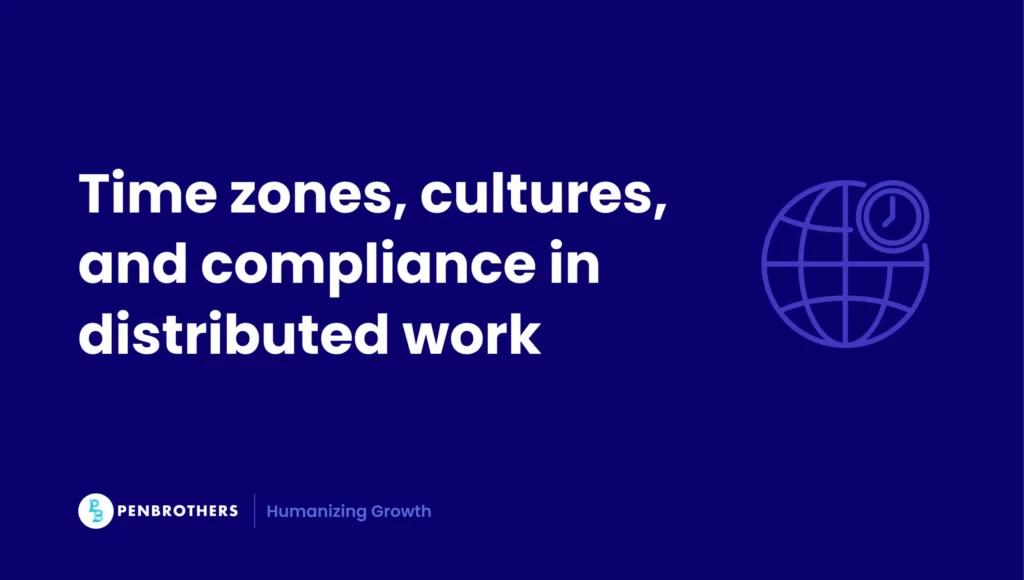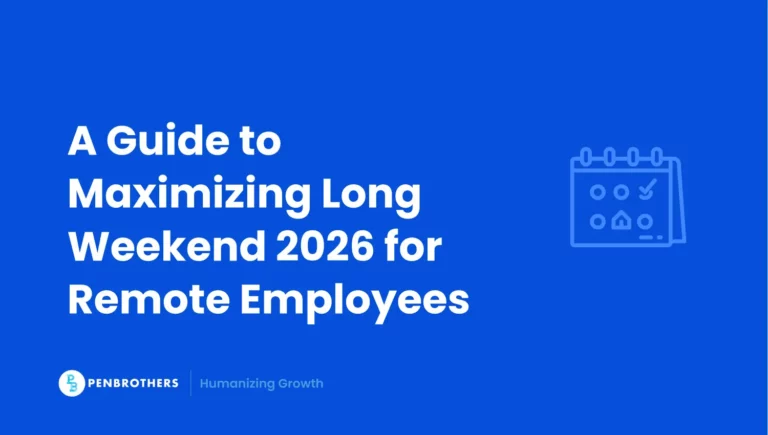The 3 AM Slack notification from your Manila developer. The 6 AM video call with your Berlin marketing team. The ongoing confusion about whether your London contractor qualifies for benefits after working 35 hours this week. Welcome to the reality of global remote work.
Ask “how many hours is full time” in a traditional office, and you get a straightforward response: usually 40 hours, sometimes 35, depends on the company. Ask the same question when your team spans six time zones and four legal jurisdictions, and you discover that full-time employment is less a number than a negotiation between laws, cultures, and operational reality.
The old frameworks are breaking. A developer in the Philippines works under different labor laws than a designer in Portugal. Your marketing manager in Mexico observes different holidays than your sales director in Singapore. Meanwhile, you’re trying to run a business that operates across all these differences without falling into legal grey areas or burning out your best people.
Traditional full-time definitions assume everyone works in the same place, under the same laws, with the same cultural expectations about work and life. Remote teams operate differently. They hand off projects across time zones. They collaborate asynchronously. They blend personal schedules with professional demands in ways that make the 9-to-5 framework feel old.
This creates challenges that most business leaders never anticipated. Time zone management becomes a compliance nightmare when overtime laws vary by country. Cultural expectations clash when your German teammate expects clear boundaries while your American colleague checks email at midnight. Legal risks multiply when you’re not sure which jurisdiction governs your distributed workforce.
But companies that master these complexities gain access to global talent pools, 24-hour operational capacity, and cultural perspectives that drive innovation. The question becomes how to navigate full-time employment definitions across international remote teams while maintaining compliance, respecting cultural differences, and building sustainable operations.
This guide reveals the strategies that leading companies use to address these challenges. We’ll examine legal definitions by region, explore time zone management approaches that work, decode cultural work hour expectations, and provide practical frameworks for building global teams that thrive across borders and time zones.
The Global Patchwork: Full-Time Definitions by Region
Here’s the thing about building global teams: every country you add to your roster brings its own definition of what full-time work means. And these definitions don’t just vary slightly. They contradict each other in ways that can make compliance feel like solving a Rubik’s cube blindfolded.
United States: Flexibility by Design
The US takes a uniquely hands-off approach. The Fair Labor Standards Act, which governs most employment law, simply doesn’t define full-time work. At all. The federal government essentially says, “Figure it out yourselves.”
This creates interesting dynamics. The IRS jumps in with its own definition for healthcare purposes: 30 hours per week qualifies as full-time under the Affordable Care Act. Meanwhile, most businesses operate on the assumption that 40 hours equals full-time, though plenty accept 35 hours as the threshold.
For remote teams, this flexibility becomes both blessing and curse. Your California employees might have different break requirements than your Texas workers. Some states mandate overtime after eight hours in a day, others only care about the weekly total. When your distributed team spans multiple states, you’re juggling different rules for people doing identical work.
European Union: Structured but Variable
Cross the Atlantic, and you encounter a completely different philosophy. The EU sets a firm ceiling: 48 hours per week maximum, including overtime. But within that framework, individual countries interpret “full-time” however they choose.
France famously established the 35-hour workweek in 2000, though actual practice often differs. Workers average around 30.7 hours weekly, making it one of the shortest workweeks globally. Germany is considering a Mobile Work Act that would give employees the legal right to work from home 24 days per year, though the legislation remains stalled.
The Netherlands takes the crown for work-life balance, with employees averaging just 31.6 hours per week. Poland sits on the opposite end, with workers putting in 39.8 hours weekly. Both countries operate under the same EU framework, yet their work cultures couldn’t be more different.
Then there’s the growing “Right to Disconnect” movement. Countries like Portugal and Belgium have passed laws protecting employees from after-hours communications. Imagine managing a global team when some members can legally ignore your evening Slack messages.
Asia-Pacific: Rapid Evolution
This region presents perhaps the most complex landscape for remote teams. Japan maintains a 40-hour standard but is undergoing a cultural revolution around work-life balance. The government actively promotes “premium Friday” campaigns encouraging workers to leave early.
Singapore offers more flexibility with overtime arrangements, while Australia caps the standard workweek at 38 hours and recently passed Right to Disconnect legislation. Your Sydney team member can now legally ignore calls after hours.
The Philippines operates on an 8-hour daily, 48-hour weekly maximum, but with nuances around overtime calculations that can trip up foreign employers. Cultural expectations around availability and hierarchy add another layer of complexity.
Rest of World: Emerging Standards
The International Labour Organization provides loose guidelines: 48 hours for regular work, with recommendations trending toward 40 hours. But these are suggestions, not mandates.
Latin American countries generally follow stricter labor protections than the US. African nations vary wildly depending on colonial legal inheritance and economic development. Middle Eastern countries often accommodate religious observances that affect scheduling.
The compliance challenge multiplies exponentially with each new jurisdiction. What works in Mexico might violate labor law in Morocco. Your contract templates, HR policies, and payroll systems all need localization.
Key Insight: No universal definition exists. Companies building global teams must navigate 195+ different legal frameworks, each with unique interpretations of full-time employment, overtime calculations, and worker protections.
The patchwork isn’t getting simpler. If anything, the trend toward worker protections and cultural accommodation is making international employment more complex, not less. Smart companies are learning to see this complexity as a competitive advantage rather than an obstacle.
Time Zones: The Hidden Compliance Challenge
Here’s what most compliance teams miss: time zones don’t just complicate scheduling. They create a hidden web of legal risks that can trap even the most careful employers.
The Overlap Problem
Recent Harvard Business School research reveals the scale of the challenge. Only 57% of remote communication happens during standard business hours, while 43% occurs when at least one employee is working outside their local schedule. Think about what that means for compliance.
The burden doesn’t fall equally. Managers carry the heaviest time-shifting load, often working early mornings and late evenings to connect with distributed teams. But the pattern gets more complex when you consider gender dynamics. Women are significantly less likely to work off-hours, even as schedule mismatches increase. They may be juggling caregiving responsibilities that make 6 AM calls or 10 PM Slack responses impossible.
Legal constraints create another layer of disparity. Countries with strict working hour limits see only 9% of communication outside business hours, compared to 32% in countries without such protections. Your Barcelona developer operates under different rules than your Austin counterpart, even when they’re collaborating on identical projects.
Compliance Nightmares
Now the legal problems multiply. Whose jurisdiction governs overtime calculations when your New York manager schedules a mandatory 7 PM call with the Manila team? Is that overtime for the American or the Filipino worker? Both? Neither?
Break requirements become a puzzle across time zones. The EU mandates 11 consecutive hours of daily rest. Your German engineer finishes at 6 PM local time, but receives urgent requests from the California team at 10 PM. Has the company violated labor law? The answer depends on response expectations, documentation, and how “urgent” gets defined.
Documentation turns into a nightmare. You need to track hours across multiple legal systems, each with different overtime thresholds, break requirements, and record-keeping mandates. A single project might involve workers under California labor law (daily overtime after 8 hours), German working time directives (48-hour weekly maximums), and Philippine labor code (different holiday schedules).
Liability questions get murkier when employees work from home across borders. Who ensures workplace safety for your contractor in Buenos Aires? What happens when someone gets injured during a late-night video call from their kitchen table?
The Cost of Poor Management
Poor time zone management creates career penalties that most companies never track. When critical information gets shared during a Thursday afternoon call that excludes the Asia-Pacific team, career advancement suffers. People miss context, lose influence, and eventually start looking for opportunities where time zones work in their favor.
Burnout accelerates when 43% of communication happens outside business hours. High performers feel pressure to be always available, while others disconnect entirely. The result: talent hemorrhage that companies attribute to other factors.
Legal exposure multiplies quietly. Compliance violations across jurisdictions rarely get discovered until someone files a complaint or a government audit reveals systemic problems. By then, the costs compound across multiple countries and regulatory frameworks.
Some Practical Solutions
Smart companies default to asynchronous communication. Document decisions in shared spaces. Record important meetings with summaries. Create systems where information flows without requiring everyone to be awake simultaneously.
Time zone equity matters. Rotate inconvenient meeting times so the burden doesn’t always fall on the same regions. If someone takes the 6 AM call this week, someone else takes it next week.
Respect local boundaries. Know the labor laws in every jurisdiction where you have workers. Build systems that automatically flag potential violations before they occur.
Technology should support async collaboration. Invest in tools that enable handoffs across time zones: project management platforms, shared documentation systems, asynchronous video updates. The goal is progress without requiring simultaneous presence.
The companies that solve time zone compliance don’t just avoid legal problems. They unlock global talent pools while building sustainable operations that respect both business needs and human limits.
Cultural Expectations: When Full-Time Means Different Things
Your Norwegian developer logs off at 4 PM sharp and won’t check email until Monday. Your Tokyo designer stays until 9 PM even when projects are finished. Your Mexico City project manager takes a two-hour lunch break and considers it normal. Welcome to the reality where “full-time” is filtered through cultural expectations that shape how, when, and why people work.
Work-Life Balance Spectrums
The Scandinavian approach treats work as just one part of a balanced life. Denmark leads the world in flat workplace hierarchies, where challenging your boss is not just acceptable but expected. Employees average 31-35 hours per week, take 25 paid vacation days annually, and prioritize family time over overtime. Norwegian workers average 38 hours weekly but rank third globally for productivity. The message: efficiency over hours.
East Asian cultures traditionally emphasize different values. Hierarchical respect, longer hours, and company loyalty define professional dedication. In Japan, staying late signals commitment even when work is finished. South Korea’s corporate culture values group harmony over individual schedules. Though younger generations are pushing back through movements like “lying flat” in China, these deep-rooted expectations still influence workplace norms.
The American standard splits the difference with individual responsibility and flexibility focus. The 40-hour week remains the norm, but expectations around availability vary wildly by company and industry. Success often means personal sacrifice, but workers demand more autonomy than their Asian counterparts.
Latin perspectives integrate family and relationship-first attitudes. The traditional siesta reflects a different relationship with time and rest. Business happens over long lunches. Personal relationships drive professional opportunities in ways that might seem nepotistic to Northern Europeans but represent cultural values around trust and community.
Communication Styles and Hours
High-context cultures require relationship building that demands synchronous time. In Japan, China, or Brazil, understanding comes through shared experiences, non-verbal cues, and contextual knowledge built over time. These cultures need face-to-face meetings, extended discussions, and consensus-building processes that can’t be rushed into asynchronous workflows.
Low-context cultures like Germany and the United States prioritize explicit information transfer. Instructions should be clear, direct, and detailed. Meetings have agendas. Decisions happen quickly. This communication style adapts naturally to asynchronous collaboration because the focus is on information exchange rather than relationship maintenance.
Protocol expectations affect scheduling in subtle ways. Formal cultures require advance notice, structured meetings, and careful attention to hierarchy when scheduling calls. Informal cultures allow last-minute changes and direct communication across organizational levels.
Decision-making styles create different time requirements. Centralized cultures need access to key decision-makers during their business hours. Collaborative cultures require group availability for consensus-building, which becomes complex across time zones.
Religious and Cultural Considerations
Islamic work schedules revolve around five daily prayers that shift with sunrise and sunset. Prayer times fluctuate throughout the year, meaning summer schedules differ from winter ones. Friday congregational prayers require extended lunch breaks. During Ramadan, some countries reduce working hours to six per day while employees adjust to fasting schedules.
Jewish communities observe Sabbath from Friday evening to Saturday evening, creating scheduling considerations for global teams. Major holidays like Rosh Hashanah and Yom Kippur require time off that may not align with company calendars.
Christian traditions still influence business cycles in many countries, with Christmas and Easter seasons affecting availability. Sunday remains a protected day in much of Europe and Latin America.
Hindu and Buddhist festivals follow lunar calendars, creating floating holidays that require flexible scheduling. Diwali, Chinese New Year, and other celebrations involve extended family obligations that affect work availability.
Even secular variations matter. National holidays, cultural celebrations, and regional observances create scheduling complexity that multiplies across global teams.
Real-World Examples
A US-Philippines team demonstrates the complexity perfectly. Twelve-hour time differences mean minimal overlap, but English proficiency enables strong asynchronous collaboration. The challenge: American individualism meets Filipino relationship-first culture. Americans want quick decisions; Filipinos prefer consensus. Americans schedule tightly; Filipinos build buffer time for family obligations.
Germany-India partnerships face different tensions. Only 4.5 hours of time difference seems manageable until cultural expectations collide. German direct communication meets Indian hierarchical respect. Germans expect punctual starts and prompt decisions. Indians require relationship building and superior approval for changes. The small time difference creates false confidence that cultural differences won’t matter.
Australia-Mexico collaboration spans 15+ hours and seasonal variations when Southern Hemisphere winter meets Northern Hemisphere summer. Australian egalitarian culture meets Mexican family-first priorities. Australians plan quarterly; Mexicans adapt daily. Both cultures value relationships, but express them differently through work patterns.
Cultural Intelligence Framework
Start with research into local labor laws and customs before building international teams. Understand both legal requirements and cultural expectations that may extend beyond formal rules.
Survey your team about preferences and constraints. Ask about religious observances, family obligations, communication styles, and scheduling preferences. Create space for these conversations without making assumptions.
Establish clear boundaries and expectations that respect cultural differences while maintaining business needs. Document what times require immediate responses versus what can wait. Clarify decision-making processes and authority levels.
Create flexible policies that accommodate differences rather than forcing uniformity. Rotate inconvenient meeting times, respect local holidays, and adapt communication styles to match cultural contexts.
It’s also a good idea to build in regular review and adjustment based on feedback. Cultural intelligence grows through experience and honest evaluation of what works across different contexts.
The companies that master cultural expectations don’t just avoid misunderstandings. They unlock the strengths that diverse work cultures bring: Scandinavian efficiency, Asian dedication, American innovation, Latin relationship building. The key is recognizing that full-time means different things to different people, and that’s precisely what makes global teams powerful.
Legal Compliance Across Borders
Here’s the uncomfortable truth about global teams: every country you hire in comes with its own legal baggage. What looks like a simple remote hiring decision can trigger compliance obligations in jurisdictions you never intended to enter.
Employment Classification Challenges
Worker classification varies dramatically by country, and getting it wrong costs more than money. The US focuses on behavioral and financial control. The Netherlands just lifted its enforcement moratorium, meaning misclassification penalties now apply immediately. Australia can fine corporations $63,000 per violation.
Your Philippine contractor might legally qualify as an employee under local labor code while remaining a contractor under US tax law. This creates dual obligations: Philippine employment protections plus American tax withholding. Now multiply that complexity across every jurisdiction where your team operates.
Benefits obligations add another layer. Health insurance requirements, retirement contributions, vacation mandates, and social security systems all vary by country. What qualifies as adequate coverage in one jurisdiction may violate minimum standards in another.
Termination procedures get equally complex. Notice periods range from zero days in some US states to months in European countries. Severance calculations follow different formulas. Documentation requirements span simple at-will termination to formal performance improvement processes.
Emerging Legislation Trends
Right to Disconnect laws continue spreading beyond Europe. Portugal, France, and Belgium lead the charge, but expect similar regulations in other regions as remote work normalizes. These laws create enforceable boundaries around after-hours communication.
Germany’s proposed Mobile Work Act would grant employees legal rights to remote work, shifting the default from employer discretion to employee entitlement. Other European countries are watching this development closely.
Tax treaties help avoid double taxation for nomadic workers, but they require careful navigation. Digital nomad visas create new categories of worker mobility that existing tax frameworks struggle to address.
Platform regulations targeting gig economy classification create pressure on companies using contractor relationships. California’s AB5, similar laws in other states, and international equivalents make contractor relationships more difficult to maintain.
Risk Mitigation Strategies
Offshore staffing companies and Professional Employer Organizations provide local compliance expertise without requiring entity establishment. They handle payroll, benefits, and legal compliance while you maintain operational control. Plus, they absorb much of the regulatory complexity that overwhelms growing companies.
Regular legal review also becomes essential as regulations evolve. Quarterly audits of multi-country policies help identify compliance gaps before they become violations.
Clear contracts with jurisdiction clauses and dispute resolution procedures prevent legal limbo when problems arise. Document everything: time tracking, communication records, policy acknowledgments. Digital nomads and distributed teams create evidence challenges that traditional employment relationships never faced.
That’s why smart companies treat compliance as a competitive advantage rather than a necessary evil. Getting the legal framework right unlocks global talent pools while competitors struggle with regulatory uncertainty. The complexity is real, but so is the opportunity for companies that master international employment law.
Key Takeaways and Next Steps
Essential Points:
- No universal full-time definition exists globally
- Time zone management requires strategic planning and cultural intelligence
- Legal compliance varies dramatically across 195+ jurisdictions
- Success requires technology, clear policies, and human empathy
Next Steps:
- Audit your current global team policies for compliance gaps
- Survey remote employees about cultural needs and preferences
- Implement asynchronous-first communication protocols
- Consider a partnership with offshore staffing companies
Ready to build a global remote team that works? Contact our international employment specialists for a complimentary consultation on compliant and culturally-intelligent remote hiring strategies.






